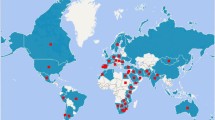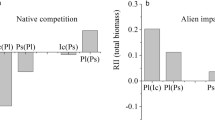Abstract
The worldwide trade of agricultural products and high levels of disturbance and fertilisation make arable lands particularly vulnerable to biological invasions. Clearing for the development of arable land has been an unprecedented event that created a new and more homogeneous habitat which allowed many species to spread to become (sub)cosmopolitan weeds, pests, and pathogens. Through competition for light, water, and nutrients (weeds), or destruction of plant tissue (pests and pathogens), harmful organisms can potentially reduce crop yield by 10–40 % on average. Historically, some non-native species produced spectacular invasions and caused incalculable damage by annihilating crop production at large scales: for example, potato late blight, Phytophthora infestans, which was one of the factors causing the Irish Potato Famine, and the American vine phylloxera, Daktulosphaira vitifoliae, which devastated vineyards across the whole of Europe. Nowadays, it is estimated that non-native weeds, pests, and pathogens cause as much as US$248 billion in annual losses to world agriculture, making this the sector most affected by the introduction of non-native species. The use of pesticides has long protected crop yield satisfactorily. However, because of the undesirable side effects that may be associated with pesticide use (e.g., development of resistant biotypes and water pollution), more integrated approaches to combat invasive species are needed, including prevention (phytosanitary control) and cropping systems with higher potential for ecological regulation.
Access this chapter
Tax calculation will be finalised at checkout
Purchases are for personal use only
Similar content being viewed by others
References
Altieri MA (1999) The ecological role of biodiversity in agroecosystems. Agric Ecosyst Environ 74:19–31
Baker HG (1965) Characteristics and mode of origin of weeds. In: Baker HG, Stebbins GL (eds) The genetics of colonizing species. Academic Press, New York, pp 147–172
Banke S, McDonald BA (2005) Migration patterns among global populations of the pathogenic fungus Mycosphaerella graminicola. Mol Ecol 14:1881–1896
Beckie HJ, Francis A, Hall LM (2012) The biology of Canadian weeds. 27. Avena fatua L. (updated). Can J Plant Sci 92(7):1329–1357
Bolda MP, Goodhue RE, Zalom FG (2010) Spotted wing drosophila: potential economic impact of a newly established pest. Agric Resour Econ Update 13(3):5–8
Booth BD, Murphy SD, Swanton CJ (2003) Plant invasions. In: Booth BD, Murphy SD, Swanton CJ (eds) Weed ecology in natural and agricultural systems. CABI, Oxford, pp 235–253
DAISIE (2009) Handbook of Alien Species in Europe. Invading nature. Springer series in invasion ecology, vol 3. Springer, Dordrecht
Desprez-Loustau ML, Robin C, Buée M et al (2007) The fungal dimension of biologic invasions. Trends Ecol Evol 22:472–480
Desprez-Loustau ML, Courtecuisse R, Robin C et al (2010) Species diversity and drivers of spread of alien fungi (sensu lato) in Europe with a particular focus on France. Biol Invasions 12:157–172
Fried G, Chauvel B, Reboud X (2009) A functional analysis of large-scale temporal shifts from 1970 to 2000 in weed assemblages of sunflower crops in France. J Veg Sci 20(1):49–58
Harker KN, Clayton GW, O’Donovan JT (2005) Reducing agroecosystem vulnerability to weed invasion. In: Inderjit S (ed) Invasive plants: ecological and agricultural aspects. Birkhäuser, Basel, pp 195–207
Hutchison WD, Burkness EC, Mitchell PD et al (2010) Areawide suppression of European corn borer with Bt maize reaps savings to non-Bt maize growers. Science 330(6001):222–225
Jones DR, Baker RHA (2007) Introductions of non-native plant pathogens into Great Britain, 1970–2004. Plant Pathol 56:891–910
Kuester A, Conner J, Culley T et al (2014) How weeds emerge: a taxonomic and trait-based examination using United States data. New Phytol 202:1055–1068
Leskey TC, Hamilton GC, Nielsen AL et al (2012) Pest status of the brown marmorated stink bug, Halyomorpha halys in the USA. Outlooks Pest Manag 23(5):218–226
Oerke E (2006) Crop losses to pests. J Agric Sci 144:31–43
Parker C (2009) Observations on the current status of Orobanche and Striga problems worldwide. Pest Manag Sci 65:453–459
Pimentel D, McNair S, Janecka J et al (2001) Economic and environmental threats of alien plant, animal, and microbe invasions. Agric Ecosyst Environ 84:1–20
Pimentel D, Zuniga R, Morrison D (2005) Update on the environmental and economic costs associated with alien-invasive species in the United States. Ecol Econ 52:273–288
Robinson RA (1976) Plant pathosystems. Springer-Verlag, Berlin
Roques A, Kenis M, Lees D et al (eds) (2010) Alien terrestrial arthropods of Europe. BioRisk 4(1). Pensoft, Sofia
Sikora EJ, Allen TW, Wise KA et al (2014) Coordinated effort to manage soybean rust in North America: a success story in soybean disease monitoring. Plant Dis 98:864–875
Soliman T, Mourits MCM, Oude Lansink AGJM et al (2012) Quantitative economic impact assessment of an invasive plant disease under uncertainty: a case study for potato spindle tuber viroid (PSTVd) invasion into the European Union. Crop Prot 40:28–35
Tiley GED (2010) Biological flora of the British Isles: Cirsium arvense (L.) Scop. J Ecol 98(4):938–983
van der Graaff NA, Khoury W (2010) Biosecurity in the movement of commodities as a component of global food security. In: Strange RN, Gullino ML (eds) The role of plant pathology in food safety and food security, vol 3. Plant pathology in the 21st century. Springer Netherlands, Dordrecht, pp 25–39
Vilà M, Williamson M, Lonsdale M (2004) Competition experiments in alien weeds with crops: lessons for measuring invasive impact? Biol Invasions 6:59–69
Williams F, Eschen R, Harris A et al (2010) The economic cost of invasive non-native species on Great Britain. CABI, Wallingford
Willis RJ (2007) The history of allelopathy. Springer, Dordrecht
Wrather A, Shannon G, Balardin R et al (2010) Effect of diseases on soybean yield in the top eight producing countries in 2006. Plant Health Progress. doi:10.1094/PHP-2010-0125-01-RS
Zimdahl RL (2004) Weed–crop competition: a review, 2nd edn. Blackwell, Oxford
Acknowledgments
We thank F.D. Panetta, an anonymous reviewer, and M. Vilà for their help in improving earlier versions of the chapter.
Author information
Authors and Affiliations
Corresponding author
Editor information
Editors and Affiliations
Rights and permissions
Copyright information
© 2017 Springer International Publishing Switzerland
About this chapter
Cite this chapter
Fried, G., Chauvel, B., Reynaud, P., Sache, I. (2017). Decreases in Crop Production by Non-native Weeds, Pests, and Pathogens. In: Vilà, M., Hulme, P. (eds) Impact of Biological Invasions on Ecosystem Services. Invading Nature - Springer Series in Invasion Ecology, vol 12. Springer, Cham. https://doi.org/10.1007/978-3-319-45121-3_6
Download citation
DOI: https://doi.org/10.1007/978-3-319-45121-3_6
Published:
Publisher Name: Springer, Cham
Print ISBN: 978-3-319-45119-0
Online ISBN: 978-3-319-45121-3
eBook Packages: Biomedical and Life SciencesBiomedical and Life Sciences (R0)




